Product description
The Qualcomm PM-7250B-0-FOWPSP110-HR-00-0 is engineered to meet the rigorous demands of contemporary electronic devices, particularly in the mobile and IoT sectors. Its architecture is optimized for high performance and low power consumption, making it ideal for smartphones, tablets, wearables, and other portable devices.
The PMIC features advanced control algorithms that ensure stable output voltages under varying load conditions. This stability is critical for maintaining the performance of sensitive components, such as CPUs and GPUs, which can experience significant fluctuations in power demand during operation. The ability to provide consistent power levels enhances the overall user experience by ensuring smooth operation and responsiveness.
In addition to its power management capabilities, the PM-7250B integrates several communication interfaces, allowing it to interface seamlessly with microcontrollers and other system components. This integration simplifies the design process, reduces the number of external components required, and ultimately leads to a more compact and cost-effective solution.
Thermal management is another critical aspect of the PM-7250B's design. With built-in thermal shutdown capabilities, the PMIC can protect itself and the overall system from overheating, which is particularly important in high-performance applications where heat generation can be substantial. This feature not only enhances the reliability of the device but also contributes to the longevity of the overall system.
Overall, the Qualcomm PM-7250B-0-FOWPSP110-HR-00-0 stands out as a versatile and efficient power management solution, capable of meeting the demanding requirements of modern electronic devices while ensuring reliability, performance, and safety. Its combination of features and specifications makes it an ideal choice for designers looking to optimize power management in their applications, providing a robust solution for a wide range of electronic devices.
Specification parameters
Input Voltage Range: The PMIC operates within a specified input voltage range, typically accommodating a variety of power sources, including batteries and external power supplies. This flexibility allows it to be used in diverse applications.
Output Voltage Range: The device can provide multiple output voltages, which can be configured to meet the specific requirements of different components within the system. This configurability is essential for optimizing power delivery to various parts of the device.
Output Current Capacity: The PM-7250B is capable of delivering substantial output current across its channels, ensuring that it can power high-demand components without performance degradation. This capability is crucial for devices that require significant power for processing and operation.
Switching Frequency: The PMIC operates at a defined switching frequency, which impacts its efficiency and response time. A higher switching frequency can lead to smaller passive components but may also increase switching losses, necessitating a balance between size and efficiency.
Package Type: The PM-7250B is available in a compact package type, which is essential for integration into space-constrained designs. This compact packaging facilitates easier assembly and reduces overall system size.





